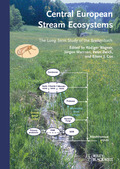Central European Stream Ecosystems
The Long Term Study of the Breitenbach

1. Edition November 2011
XXII, 672 Pages, Hardcover
348 Pictures (73 Colored Figures)
107 tables
Handbook/Reference Book
Wiley Online LibraryContentSample ChapterIndexSupplementary Material
Short Description
This is an unmatched long-term study of a central European stream analyzing the changes in species frequency and occurrence in relationship to climate variation and other environmental change. Invaluable data for anyone wanting to understand the ecology of streams.
Buy now
Price: 209,00 €
Price incl. VAT, excl. Shipping
Euro prices for Wiley-VCH and Ernst & Sohn titles are only valid for Germany. In EU countries, local VAT applies. Postage will be charged.
Probably the best-studied stream on earth.
The result of unmatched long-term data taken by the Max-Planck outstation in Schlitz from the nearby Breitenbach stream since 1949, the special focus in this handbook and ready reference is on animal and microorganism occurrence and variation, as well as chemical and physical parameters.
An invaluable data basis for modeling purposes for anyone dealing with stream ecology.
The Breitenbach and its Catchment
Environmental Characteristics
Detrital Energy Sources
Primary Producers
Bacteria and Fungi
The Fauna of the Breitenbach
Ecosystem Breitenbach
Summary
Jürgen Marxsen was scientific assistant at the Limnologische Fluss-Station Schlitz, a field station of the former Max-Planck-Institute for Limnology (now MPI for Evolutionary Biology) from 1977 to 2006. He obtained his scientific degrees from the University of Kiel. Since 2006 at the Department of Animal Ecology associated to the Interdisciplinary Research Center for Biosystems, Land Use and Nutrition (IFZ) at the University of Giessen. His research activities include stream and groundwater microbial ecology, particularly the role of bacteria in the carbon flow, bacterial production, extra-cellular enzyme activity, application of molecular techniques to microbial ecology, impact of climatic change on running water microbial communities. He is member of editorial boards and ad-hoc referee for scientific journals and national funding organizations.
Since 1968 Peter Zwick was member of the staff of the Limnologische Fluss-Station Schlitz, a field station of the former Max-Planck-Institute for Limnology (now MPI for Evolutionary Biology) and was the scientific head from 1982 to 2006. He obtained his scientific degrees from the University of Kiel. P. Zwick is a world authority in Plecoptera (stone-flies), and other groups of aquatic insects. For his studies he was awarded the `Fabricius Medaille? of the German Society for General and Applied Entomology (1982). His research activities include among many others the general biology of aquatic insects including aspects of phylogeny, ecology and physiology. He was editor of scientific journals, member of editorial boards and an referee of many scientific journals, funding organizations and more.
Eileen Cox was a Deutsche Forschungsgemeinschaft-funded research fellow at the Limnologische Fluss-Station Schlitz from 1985 to 1988, and a scientific assistant there from 1988 to 1989. She obtained her degrees from the University of Bristol (England). Between 1989 and 1992, she was a researcher at the University of Sheffield (England), a research scientist at the Natural History Museum, London since 1992, and Head of Postgraduate Studies at the NHM since 2007. She has authored over 100 research publications, with a particular focus on diatom taxonomy, systematics, ecology and development. She is a past-president of the British Phycological Society and of the International Society for Diatom Research, a former Editor-in-chief of the European Journal of Phycology, and has held other key positions on the councils of learned societies. She has reviewed extensively for scientific journals and grant awarding bodies.


